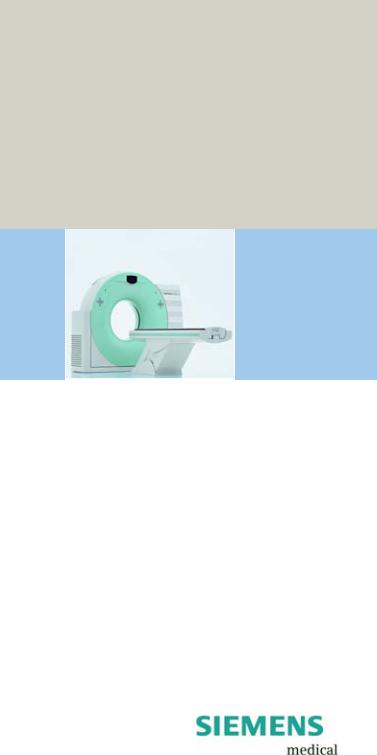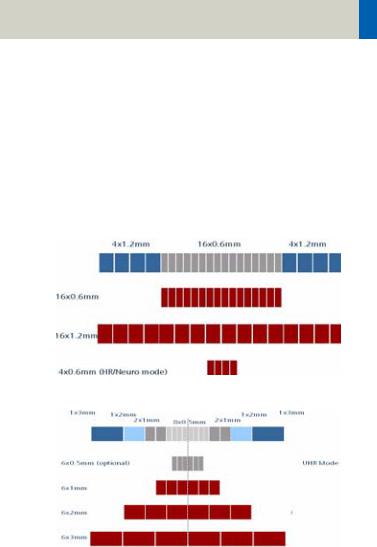Siemens EMOTION 16-6 User Manual

SOMATOM Emotion 6/16-slice configuration
Application Guide
Protocols
Principles
Helpful Hints
Software Version syngo CT 2007E
The information presented in this application guide is for illustration only and is not intended to be relied upon by the reader for instruction as to the practice of medicine. Any health care practitioner reading this information is reminded that they must use their own learning, training and expertise in dealing with their individual patients.
This material does not substitute for that duty and is not intended by Siemens Medical Solutions Inc., to be used for any purpose in that regard. The drugs and doses mentioned herein are consistent with the approval labeling for uses and/or indications of the drug. The treating physician bears the sole responsibility for the diagnosis and treatment of patients, including drugs and doses prescribed in connection with such use. The Operating Instructions must always be strictly followed when operating the MR/CT System. The source for the technical data is the corresponding data sheets.
The pertaining operating instructions must always be strictly followed when operating the SOMATOM Emotion 6/16-slice configuration. The statutory source for the technical data are the corresponding data sheets.
We express our sincere gratitude to the many customers who contributed valuable input.
Special thanks to Christiane Bredenhoeller, Gabriel Haras, Ute Feuerlein, Jessica Amberg, Thomas Flohr, Rainer Raupach, Bettina Hinrichsen, Axel Barth, Kristin Pacheco and the CT-Application Team for their valuable assistance.
To improve future versions of this application guide, we would highly appreciate your questions, suggestions and comments.
Please contact us: USC-Hotline:
Tel. no. +49-1803-112244
email ct-application.hotline@med.siemens.de
Editors: Wang Jian, Chen Ma Hao

Overview
|
User Documentation |
16 |
|
Scan and Reconstruction |
18 |
|
||
|
Dose Information |
42 |
|
||
|
||
|
Workflow Information |
64 |
|
||
|
||
|
Contrast Medium |
122 |
|
||
|
||
|
Application Information |
136 |
|
||
|
||
|
Head |
162 |
|
||
|
||
|
Neck |
204 |
|
||
|
||
|
Shoulder |
218 |
|
||
|
||
|
Thorax |
226 |
|
||
|
||
|
Abdomen |
262 |
|
||
|
||
|
Spine |
294 |
|
||
|
||
|
Pelvis |
314 |
|
||
|
||
|
Upper Extremities |
332 |
|
||
|
||
|
Lower Extremities |
346 |
|
||
|
||
|
Vascular |
360 |
|
||
|
||
|
Specials |
416 |
|
||
|
||
|
Radiation Therapy |
462 |
|
||
|
||
|
|
|
3

Overview
|
Respiratory Gating |
484 |
|
Children |
508 |
|
||
|
|
|
4

Overview
5

Contents
|
User Documentation |
16 |
|
|
Scan and Reconstruction |
18 |
|
|
|||
|
• Concept of Scan Protocols |
18 |
|
|
|||
|
• Scan Set Up |
19 |
|
|
• Feed in/Feed out |
19 |
|
|
• Topo Length |
20 |
|
|
• Scan Modes |
21 |
|
- |
Sequential Scanning |
21 |
|
- |
Spiral Scanning |
21 |
|
- |
Quick Scan |
22 |
|
- |
Dynamic Multiscan |
22 |
|
- |
Dynamic Serioscan |
22 |
|
|
• UFC detector |
23 |
|
|
• Acquisition, Slice Collimation and Slice Width |
||
|
|
|
24 |
|
- SOMATOM Emotion 16-slice configuration |
||
|
|
|
25 |
|
- SOMATOM Emotion 6-slice configuration 26 |
||
|
• Increment |
27 |
|
|
• Pitch |
27 |
|
|
• Kernels |
28 |
|
- |
Head Kernels |
32 |
|
- |
Child Head Kernels |
32 |
|
- |
Body Kernels |
33 |
|
|
- Special Application Kernels 33 |
|
|
|
• Extended FoV |
34 |
|
|
• Auto-FoV |
35 |
|
|
• Neuro Modes |
37 |
|
|
• Automatic Bone Correction |
38 |
|
|
• Positioning |
39 |
|
|
• Image Filters |
40 |
|
|
Dose Information |
42 |
|
|
|||
|
• CTDIW and CTDIVol |
42 |
|
|
|||
|
• ImpactDose |
44 |
|
|
• Effective mAs |
45 |
|
6

Contents
• CARE Dose 4D |
47 |
- How does CARE Dose 4D work? |
49 |
- Special Modes of CARE Dose 4D |
53 |
- Scanning with CARE Dose 4D |
54 |
- Adjusting the Image Noise |
58 |
- Activating and Deactivating |
61 |
-Conversion of Old Protocols into Protocols with CARE Dose 4D 61
- |
Additional Important Information |
63 |
|
|
Workflow Information |
64 |
|
|
|||
|
• WorkStream4D |
64 |
|
|
|||
- |
Recon Jobs |
64 |
|
- |
3D Recon |
65 |
|
- |
1. Sagittal/Coronal Reconstructions |
71 |
|
- |
2. Oblique/Double-oblique Reconstructions |
||
|
|
|
71 |
|
- Non-square Matrix for 3D Recon |
76 |
|
|
- Case Examples for 3D Recon and Non-Square |
||
|
|
Matrix |
77 |
|
• Workflow |
79 |
|
- |
Patient Position |
79 |
|
- |
Auto Reference Lines |
79 |
|
|
- Navigation within the Topogram |
80 |
|
- |
API Language |
81 |
|
|
• e - Logbook |
83 |
|
- |
e- Logbook Configuration |
83 |
|
|
- e- Logbook subtask card area |
87 |
|
- |
e- Logbook Browser |
88 |
|
- |
Study Continuation |
91 |
|
|
- Reconstruction on the syngo CT Workplace |
||
|
|
|
92 |
- |
Examination Job Status |
93 |
|
- Auto Load in 3D and Postprocessing Presets 94 96 96 98
100
7

Contents
- |
Change parameters |
103 |
|
- |
Import scan protocols from SOMATOM |
|
|
|
|
LifeNet/CD |
117 |
|
Contrast Medium |
122 |
|
|
|||
|
• Contrast Medium |
122 |
|
|
|||
- |
The Basics |
122 |
|
- |
IV Injection |
125 |
|
|
• Bolus Tracking |
126 |
|
|
• Test Bolus using CARE Bolus |
128 |
|
|
• Test Bolus |
129 |
|
- |
CARE Contrast |
130 |
|
|
Application Information |
136 |
|
|
|||
|
• SOMATOM LifeNet |
136 |
|
|
|||
- |
General Information |
136 |
|
- |
Key Features |
137 |
|
- |
SOMATOM LifeNet offline |
138 |
|
- |
SOMATOM LifeNet online |
140 |
|
|
• Image Converter |
147 |
|
|
• Report Template Configuration |
150 |
|
|
• File Browser |
151 |
|
|
• Camtasia |
155 |
|
- |
Key features |
155 |
|
- |
Additional Important Information |
159 |
|
|
• Patient Protocol |
160 |
|
|
Head |
|
162 |
|
|
||
|
• Overview |
162 |
|
|
|||
- |
General Hints |
165 |
|
- |
Head Kernels |
166 |
|
|
• Scan Protocols |
168 |
|
- |
HeadRoutine |
168 |
|
- |
HeadNeuro |
172 |
|
- |
HeadSeq |
174 |
|
- |
InnerEarHR |
177 |
|
8

Contents
- |
InnerEarHRVol |
180 |
|
- |
InnerEar |
184 |
|
- |
InnerEarSeq |
188 |
|
- |
Sinus |
192 |
|
- |
SinusVol |
196 |
|
- |
Orbit |
198 |
|
- |
Dental |
200 |
|
|
Neck |
|
204 |
|
|
||
|
• Overview |
204 |
|
|
|||
- |
General Hints |
206 |
|
- |
Body Kernels |
207 |
|
|
• Scan Protocols |
208 |
|
- |
NeckRoutine |
208 |
|
- |
NeckThinSlice |
212 |
|
- |
NeckVol |
214 |
|
|
Shoulder |
218 |
|
|
|||
|
• Overview |
218 |
|
|
|||
- |
General Hints |
219 |
|
- |
Body Kernels |
219 |
|
|
• Scan Protocols |
220 |
|
- |
Shoulder |
220 |
|
- |
ShoulderVol |
224 |
|
|
Thorax |
226 |
|
|
|||
|
• Overview |
226 |
|
|
|||
- |
General Hints |
229 |
|
- |
Body Kernels |
231 |
|
|
• Scan Protocols |
232 |
|
- |
ThoraxRoutine/ |
|
|
|
|
ThoraxRoutine06s |
232 |
- |
ThoraxCombi/ |
|
|
|
|
ThoraxCombi06s |
235 |
- |
ThoraxVol |
240 |
|
- |
ThoraxFast/ |
|
|
9

Contents
|
|
ThoraxFast06s |
244 |
- |
ThoraxHR |
246 |
|
- |
ThoraxHRSeq |
250 |
|
- |
ThoraxECGHRSeq |
252 |
|
- |
LungLowDose/ |
|
|
|
|
LungLowDose06s |
254 |
- |
LungCARE/ |
|
|
|
|
LungCARE06s |
258 |
|
Abdomen |
262 |
|
|
|||
|
• Overview |
262 |
|
|
|||
- |
General Hints |
264 |
|
- |
Body Kernels |
265 |
|
|
• Scan Protocols |
266 |
|
- |
AbdomenRoutine/ |
|
|
|
|
AbdomenRoutine06s |
266 |
- |
AbdomenCombi/ |
|
|
|
|
AbdomenCombi06s |
270 |
- |
AbdomenVol |
274 |
|
- |
AbdomenFast/ |
|
|
|
|
AbdomenFast06s |
278 |
- |
AbdMultiPhase/ |
|
|
|
|
AbdMultiPhase06s |
280 |
- |
AbdomenSeq |
288 |
|
- |
Colonography/ |
|
|
|
|
Colonography06s |
290 |
|
Spine |
|
294 |
|
|
||
|
• Overview |
294 |
|
|
|||
- |
General Hints |
296 |
|
- |
Body Kernels |
297 |
|
|
• Scan Protocols |
298 |
|
- |
C-Spine |
298 |
|
- |
C-SpineVol |
300 |
|
- |
SpineRoutine |
302 |
|
- |
SpineThinSlice |
304 |
|
- |
SpineVol |
305 |
|
10

Contents
- |
SpineSeq |
308 |
|
- |
Osteo |
312 |
|
|
Pelvis |
|
314 |
|
|
||
|
• Overview |
314 |
|
|
|||
- |
General Hints |
316 |
|
- |
Body Kernels |
317 |
|
|
• Scan Protocols |
318 |
|
- |
Pelvis |
318 |
|
- |
PelvisVol |
322 |
|
- |
Hip |
324 |
|
- |
HipVol |
328 |
|
- |
SI_Joints |
330 |
|
|
Upper Extremities |
332 |
|
|
|||
|
• Overview |
332 |
|
|
|||
- |
General Hints |
334 |
|
- |
Body Kernels |
335 |
|
|
• Scan Protocols |
336 |
|
- |
WristHR |
336 |
|
- |
ExtrRoutineHR |
340 |
|
- |
ExtrCombi |
344 |
|
|
Lower Extremities |
346 |
|
|
|||
|
• Overview |
346 |
|
|
|||
- |
General Hints |
348 |
|
- |
Body Kernels |
349 |
|
|
• Scan Protocols |
350 |
|
- |
Knee |
350 |
|
- |
Foot |
352 |
|
- |
ExtrRoutineHR |
354 |
|
- |
ExtrCombi |
358 |
|
11

Contents
|
Vascular |
360 |
|
|
• Overview |
360 |
|
- |
General Hints |
363 |
|
- |
Head Kernels |
364 |
|
- |
Body Kernels |
365 |
|
|
• Scan Protocols |
366 |
|
- |
HeadAngio/ |
|
|
|
|
HeadAngio06s |
366 |
- |
HeadAngioVol |
370 |
|
- |
CarotidAngio/ |
|
|
|
|
CarotidAngio06s |
372 |
- |
CarotidAngioVol |
376 |
|
- |
ThorAngioRoutine/ |
|
|
|
|
ThorAngioRoutine06s |
380 |
- |
ThorAngioVol |
384 |
|
- |
ThorAngioECG/ |
|
|
|
|
ThorAngioECG06s |
388 |
- |
ThorAngioECGSeq |
392 |
|
- |
Embolism/ |
|
|
|
|
Embolism06s |
394 |
- |
BodyAngioRoutine/ |
|
|
|
|
BodyAngioRoutine06s |
398 |
- |
BodyAngioVol |
402 |
|
- |
BodyAngioFast/ |
|
|
|
|
BodyAngioFast06s |
406 |
- |
AngioRunOff/ |
|
|
|
|
AngioRunOff06s |
410 |
- |
WholeBodyAngio |
414 |
|
|
Specials |
416 |
|
|
|||
|
• Overview |
416 |
|
|
|||
- |
Trauma |
416 |
|
- |
Interventional CT |
418 |
|
- |
Test Bolus |
420 |
|
|
• Trauma Protocols |
422 |
|
- |
General Information |
422 |
|
- |
Trauma |
424 |
|
- |
TraumaVol |
425 |
|
12

Contents
- |
PolyTrauma/ |
|
|
|
|
PolyTrauma06s |
426 |
- |
HeadTrauma |
430 |
|
- |
HeadTraumaSeq |
432 |
|
- |
Additional Important Information |
434 |
|
|
• Interventional CT - Biopsy |
436 |
|
- |
Biopsy |
437 |
|
- |
Biopsy Single |
438 |
|
|
• Interventional CT - CARE Vision |
439 |
|
- |
The Basics |
439 |
|
- |
CAREVision |
440 |
|
- |
CAREVisionSingle |
441 |
|
- |
CAREVisionBone |
442 |
|
- |
HandCARE |
443 |
|
- |
Additional Important Information |
447 |
|
|
• General Information for Biopsy and CARE |
|
|
|
Vision |
450 |
|
- |
Interventional Toolbar |
450 |
|
- |
CAREView |
453 |
|
- |
Configuration |
456 |
|
- |
Routine Subtask card |
458 |
|
- |
Additional Important Information |
459 |
|
|
• TestBolus Protocol |
460 |
|
- |
TestBolus |
460 |
|
|
Radiation Therapy |
462 |
|
|
|||
|
• Radiation Therapy Planning |
462 |
|
|
|||
- |
Benefits |
465 |
|
|
• Workflow |
468 |
|
|
• Scan Protocols |
470 |
|
- |
Overview |
470 |
|
- |
RT_Head |
472 |
|
- |
RT_Thorax |
474 |
|
- |
RT_Breast |
476 |
|
- |
RT_Abdomen |
478 |
|
- |
RT_Pelvis |
480 |
|
- |
Additional Important Information |
482 |
|
13

Contents
|
Respiratory Gating |
484 |
|
|
• Key Features |
486 |
|
- |
Respiratory Gating |
486 |
|
- |
Respiration Monitoring |
486 |
|
- |
Respiration Synchronization |
487 |
|
|
• Positioning of the respiratory sensor belt |
488 |
|
|
• Scanning Information |
490 |
|
- |
Scan Parameters |
490 |
|
- |
Temporal Resolution |
491 |
|
- |
Technical Principles |
491 |
|
- |
Respiratory Triggering |
491 |
|
- |
Respiratory gating |
492 |
|
|
- Prospective respiratory triggering versus |
|
|
|
|
retrospective respiratory gating |
494 |
- |
Curve Editor |
495 |
|
- |
Synthetic Trigger/Sync |
497 |
|
|
• Workflow |
498 |
|
|
- Reconstruction and Post processing |
498 |
|
|
• Additional important Information |
499 |
|
|
• Scan Protocol |
500 |
|
- |
RespSeq |
500 |
|
- |
Resp |
502 |
|
- |
RespModBreathRate |
504 |
|
- |
RespLowBreathRate |
506 |
|
|
Children |
508 |
|
|
|||
|
• Overview |
508 |
|
|
|||
- |
General Hints |
512 |
|
- |
Head Kernels |
515 |
|
- |
Body Kernels |
516 |
|
|
• Scan Protocols |
518 |
|
- |
HeadRoutine |
518 |
|
- |
HeadSeq |
522 |
|
- |
InnerEarHR |
526 |
|
- |
InnerEar |
530 |
|
- |
InnerEarSeq |
534 |
|
- |
SinusOrbit |
538 |
|
- |
NeckRoutine |
542 |
|
14

Contents
- |
ThoraxRoutine/ |
|
|
ThoraxRoutine06s |
546 |
- |
ThoraxCombi/ |
|
|
ThoraxCombi06s |
550 |
- |
ThoraxHRSeq |
554 |
- |
AbdomenRoutine/ |
|
|
AbdomenRoutine06s |
558 |
- |
Spine/ |
|
|
SpineRoutine |
562 |
- |
SpineThinSlice |
566 |
- |
ExtrRoutineHR |
568 |
- |
ExtrCombi |
570 |
- |
HeadAngio/ |
|
|
HeadAngio06s |
574 |
- |
CarotidAngio/ |
|
|
CarotidAngio06s |
578 |
- |
BodyAngioRoutine/ |
|
|
BodyAngioRoutine06s |
582 |
- |
BodyAngioFast/ |
|
|
BodyAngioFast06s |
586 |
- |
NeonateBody/ |
|
|
NeonateBody06s |
587 |
15

User Documentation
For further information about the basic operation, please refer to the corresponding syngo CT Operator Manual:
syngo CT Operator Manual Volume 1:
syngo Security Package Siemens Virus Protection Basics
SOMATOM LifeNet syngo Patient Browser
syngo Data Set Conversion Camtasia
SaveLog E-Logbook syngo Viewing syngo Filming
syngo CT Operator Manual Volume 2:
Preparations
Examination
MPPS
HeartView CT
Respiratory Gating CT
CARE Bolus CT
CARE Vision CT
syngo CT Operator Manual Volume 3:
syngo 3D
syngo Dental CT syngo Osteo CT
16

User Documentation
syngo CT Operator Manual Volume 4: syngo LungCARE CT
syngo Pulmo CT
syngo Neuro Perfusion CT syngo Body Perfusion CT
syngo CT Operator Manual Volume 5:
syngo Calcium Scoring syngo Circulation
syngo Volume Calculation syngo Dynamic Evaluation syngo Neuro DSA CT
syngo CT Operator Manual Volume 6:
syngo InSpace 4D CT syngo Colonography
17

Scan and Reconstruction
Concept of Scan Protocols
The scan protocols for adult and children are defined according to body regions - Head, Neck, Shoulder,
Thorax, Abdomen, Pelvis, Spine, Upper Extremities, Lower Extremities, Vascular, RT, Specials and optional Cardiac, PET, SPECT and Private.
The protocols for special applications are defined in the Application Guide “Clinical Applications” or in the case of a Heart View examination, in the Application Guide “Cardiac CT“.
The general concept is as follows: All protocols without a suffix are standard spiral modes. For example, “Sinus” means the spiral mode for the sinus.
The suffixes of the protocol name are follows:
“Routine“: for routine studies
“Seq”: for sequence studies
“Fast“: use a higher pitch for fast acquisition
“ThinSlice“: use a thinner slice collimation
“Combi“: use a thinner and a thicker slice collimation
“05s”: use the rotation time of 0.5 seconds
“ECG“: use a ECG-gated or triggered mode
“Neuro“: for neurologicial examinations with a special mode
“Vol“: use the 3D Recon workflow
“HR“: use a thin slice width for High Resolution studies
A prefix of the protocol name is as follows:
“RT”: for radio therapy studies
The availability of scan protocols depends on the system configuration.
“Resp”: for respiratory gated studies
The availability of scan protocols depends on the system configuration.
18

Scan and Reconstruction
Scan Set Up
Scans can be simply set up by selecting a predefined examination protocol. To repeat any mode, just click the chronicle with the right mouse button for repeat. To delete it, select cut. Each range name in the chronicle can be easily changed before load.
Multiple ranges can be run either automatically with auto range, which is denoted by a bracket connecting the two ranges, or separately with a pause in between.
Feed in/Feed out
The performance of the different buttons (soft buttons, gantry buttons, control box buttons) is standardized as follows:
•in NOT loaded modes 1 mm
•in loaded Biopsy mode:
Feed In/Out = slice width x No. slice positions per scan 2
19

Scan and Reconstruction
Topo Length
SOMATOM
Emotion 16
Length [mm] |
128, 256, 512, 768, 1024, |
|
1500 |
|
|
Slice width [mm] |
4x0.6 |
|
|
Angle |
Top, Bottom, Lateral |
|
|
SOMATOM |
|
Emotion 6 |
|
|
|
Length [mm] |
128, 256, 512, 768, 1024, |
|
1500, 1536*, 2000**, |
|
2048*** |
|
|
Slice width [mm] |
3x1 |
|
|
Angle |
AP, PA, Lateral |
* only in combination with PET and SPECT, option
**only in combination with SPECT, option
***only in combination with PET, option
20

Scan and Reconstruction
Scan Modes
Sequential Scanning
This is an incremental, slice-by-slice imaging mode in which there is no table movement during data acquisition. A minimum interscan delay in between each acquisition is required to move the table to the next slice position.
Spiral Scanning
Spiral scanning is a continuous volume imaging mode. The data acquisition and table movements are performed simultaneously for the entire scan duration. There is no inter-scan delay and a typical range can be acquired in a single breath hold.
Each acquisition provides a complete volume data set, from which images with overlapping can be reconstructed at any arbitrary slice position. Unlike the sequence mode, spiral scanning does not require additional radiation to obtain overlapping slices.
21

Scan and Reconstruction
Quick Scan
The data is usually acquired during a full 360° rotation
– this is a Full scan. Data acquisition not using a full 360° rotation is called a “Quick scan”. Quick scans are employed to reduce motion artifacts and improve the temporal resolution.
Dynamic Multiscan
Multiple continuous rotations at the same table position are performed for data acquisition. Normally, it is applied for fast dynamic contrast studies, such as syngo Neuro Perfusion CT.
Dynamic Serioscan
Dynamic serial scanning mode without table feed. Dynamic serio can still be used for dynamic evaluation such as Test Bolus. The image order can be defined on the Recon subtask card.
22

Scan and Reconstruction
UFC detector
Siemens’ proprietary, high-speed Ultra Fast Ceramic (UFC) detector enables a virtually simultaneous readout of two projections for each detector element.
The detector configuration with the routine acquisition of the Emotion 6/16-slice configuration:
SOMATOM Emotion 16-slice configuration:
SOMATOM Emotion 6-slice configuration:
23

Scan and Reconstruction
Acquisition, Slice Collimation
and Slice Width
Slice collimation is the slice thickness resulting from the effect of the tube-side collimator and the adaptive detector array design. In Multislice CT, the Z-coverage per rotation is given by the product of the number of active detector slices and the collimation (e.g. 6 x 1.0mm for the SOMATOM Emotion 6-slice configuration or 16 x 0.6mm for the SOMATOM Emotion 16slice configuration ).
Slice width is the FWHM (full width at half maximum) of the reconstructed image.
With the SOMATOM Emotion 6/16-slice configuration, you select the slice collimation together with the slice width desired. The slice width is independent of pitch, i.e. what you select is always what you get. Actually, you do not need to care about the algorithm any more; the software does it for you.
If Metrorecon/Fastrecon is not selected you will routinely get “Real Time” images. The Recon icon on the chronicle will be labeled with “RT”. After the scan the Real Time displayed image series has to be reconstructed.
In some cases – this depends also on Scan pitch and Reconstruction increment – the Recon icon on the chronicle will be labeled with “RT”. This indicates the Real Time display of images during scanning. The Real Time displayed image series has to be reconstructed after completion of spiral.
The Acq (Acquisition) is displayed on the Examination task card. The Acquisition is simply "number of slices acquired per rotation" x "width of one slice".
24

Scan and Reconstruction
SOMATOM Emotion 16-slice configuration
Spiral Mode
Collimation/ Slice width
Acquisition
16 x 0.6 mm 0.75, 1.0, 1.5, 2.0, 3.0, 4.0, 5.0 mm
16 x 1.2 mm 1.5, 2.0, 3.0, 4.0, 5.0, 6.0, 8.0, 10.0 mm
HR/Neuro Spiral Mode
Collimation/ Slice width
Acquisition
4 x 0.6 mm 0.6, 0.75, 1.0, 1.5, 2.0, 3.0, 4.0, 5.0 mm
Sequence Mode
Collimation/ |
Slice width |
Acquisition |
|
|
|
4 x 0.6 mm |
0.6, 1.2, 2.4 mm |
|
|
12 x 0.6 mm |
0.6, 2.4, 7.2 mm |
|
|
16 x 0.6 mm |
1.2, 2.4, 4.8, 9.6 mm |
|
|
2 x 5 mm |
5.0, 10.0 mm |
|
|
12 x 1.2mm |
1.2, 3.6, 4.8 mm |
|
|
2 x 8 mm |
8.0, 16.0 mm |
16 x 1.2 mm 2.4, 4.8, 9.6, 19.2 mm
25

Scan and Reconstruction
SOMATOM Emotion 6-slice configuration
Spiral Mode
Collimation |
Slice width |
|
|
1 mm |
1, 1.25, 2, 2.5, 3, 4, 5, 6, 8, 10 mm |
|
|
2 mm |
2.5, 3, 4, 5, 6, 8, 10 mm |
|
|
3 mm |
4, 5, 6, 8, 10 mm |
|
|
Sequence Mode |
|
Collimation |
Slice width |
|
|
1 mm |
1, 2, 3 mm |
|
|
2 mm |
2, 4, 6, 12 mm |
|
|
3 mm |
3, 6, 9, 18 mm |
|
|
5 mm |
5, 10 mm |
|
|
HR Spiral Mode |
|
Collimation |
Slice width |
|
|
0.5 mm |
0.63, 0.75, 1, 1.25, 2, 2.5, 3, 4, |
|
5 mm |
|
|
HR Sequence Mode |
|
|
|
Collimation |
Slice width |
|
|
1 mm |
1 mm |
|
|
26

Scan and Reconstruction
Increment
The increment is the distance between the reconstructed images in Z direction. When the chosen increment is smaller than the slice thickness, the images are created with an overlap. This technique is useful for reducing partial volume effect, giving you better detail of the anatomy and high quality 2D and 3D postprocessing.
The increment can be freely adapted from 0.1 - 10 mm.
Pitch
Pitch = feed per rotation z-coverage
z-coverage = detector rows x collimated slice width
Feed/Rotation = table movement per rotation
The Pitch Factor can be freely adapted from 0.45 – 2.0, in Cardio, there is a fixed pitch down to 0.1.
With the SOMATOM Emotion 6/16-slice configuration, you select the slice collimation together with the slice width desired.
The slice width is independent of pitch, i.e. what you select is always what you get. Actually, you do not need to be concerned about the algorithm any more; the software does it for you.
Pitch values with a step width of 0.05 can be selected for all modes.
We recommend to use a Pitch Factor of 0.45 for MPR reconstructions.
27

Scan and Reconstruction
Kernels
There are 4 different types of kernels: “H“ stands for Head, “B“ stands for Body, “C“ stands for ChildHead and ”S” stands for Special Application, e.g. syngo Osteo CT.
The image sharpness is defined by the numbers – the higher the number, the sharper the image; the lower the number, the smoother the image.
Head Kernels:
Kernel |
description |
H10s |
very smooth |
|
|
H19s |
very smooth |
|
|
H20s |
smooth |
|
|
H21s |
smooth + |
|
|
H22s |
smooth FR + |
|
|
H29s |
smooth + |
|
|
H30s |
medium smooth |
|
|
H31s |
medium smooth + |
|
|
H32s |
medium smooth FR + |
|
|
H37s |
medium smooth (Emotion 16-slice |
|
configuration only) |
|
|
H39s |
medium smooth |
|
|
H40s |
medium |
|
|
H41s |
medium + |
|
|
H42s |
medium FR |
|
|
H45s |
medium |
|
|
H47s |
medium smooth (Emotion 16-slice |
|
configuration only) |
|
|
H48s |
medium smooth (Emotion 16-slice |
|
configuration only) |
|
|
H50s |
sharp |
|
|
H60s |
medium |
|
|
H70s |
very sharp |
|
|
H80s |
inner ear |
H90s |
inner ear |
|
|
28

Scan and Reconstruction
Body Kernels:
Kernel |
description |
B08s |
very smooth |
|
|
B10s |
very smooth |
|
|
B19s |
very smooth |
|
|
B20s |
smooth |
|
|
B29s |
smooth |
|
|
B30s |
medium smooth |
|
|
B31s |
medium smooth + |
|
|
B35s |
HeartView medium |
|
|
B39f |
HeartView medium |
|
|
B40s |
medium |
|
|
B41s |
medium+ |
|
|
B46s |
medium |
|
|
B50s |
medium sharp |
|
|
B60s |
sharp |
|
|
B65s |
sharp |
B70s |
very sharp |
|
|
B75s |
very sharp (Emotion 16-slice configu- |
|
ration only) |
|
|
B80s |
ultra sharp |
|
|
B90s |
ultra sharp |
Child Head Kernels: |
|
Kernel |
description |
C20s |
smooth |
|
|
C30s |
medium smooth |
|
|
C60s |
sharp |
29

Scan and Reconstruction
Topogram Kernels:
Kernel |
description |
T10s |
smooth |
|
|
T20s |
standard |
|
|
T21s |
standard |
|
|
T80s |
sharp |
|
|
T81s |
sharp |
|
|
T90s |
ultra sharp |
Special Application: |
|
|
|
Kernel |
description |
|
|
S30s |
Shepp-Logan |
|
|
S80s |
Shepp-Logan with notch filter |
|
|
S90s |
Shepp-Logan without notch filter |
|
|
U90s |
specification kernel |
|
|
30
